Evaluating Trends of Land Productivity Change and Their Causes in the Han River Basin, China: In Support of SDG Indicator 15.3.1
Abstract
:1. Introduction
2. Materials and Methods
2.1. Study Area
2.2. Data Sources and Processing
2.2.1. NPP Data
2.2.2. Meteorological Data
2.2.3. Topographic Data
2.2.4. Forest Cover Data
2.2.5. Human Activity Data
2.3. Methods
2.3.1. Change Trend of Land NPP
2.3.2. Sustainability Analysis of Land NPP Change
- (1)
- If 0.5 < H < 1, it is a continuous series that the future trend of land NPP change is consistent with the past. The closer H is to 1, the stronger the continuity is.
- (2)
- If H = 0.5, it is a random series that the future trend of land NPP change is irrelevant to the past.
- (3)
- If 0 < H < 0.5, it is a reverse continuous series that the future trend of land NPP change is opposite to the past. The closer H is to 0, the stronger the reverse continuity is.
2.3.3. Land Productivity Assessment Based on Trends.Earth for SDG Indicator 15.3.1
- (1)
- Trajectory—measures the rate of change in land productivity over time. Trends.Earth uses pixel-level linear regressions to identify areas where land productivity has changed during the analysis period. Mann–Kendall non-parametric tests are then performed, considering only those significant changes with a p-value ≤ 0.05. Positive significant trends in NDVI indicate potential improvement, while negative significant trends suggest potential degradation.
- (2)
- State—detects the most recent changes in land productivity compared with the baseline period. The baseline period is considered as the historical period, while the comparison period is defined as the most recent years. Then, the average NDVI is calculated for the baseline and comparison periods. The percentile class to which it belongs is determined, with possible values ranging from 1 (lowest class) to 10 (highest class). If the difference in class between the baseline period and the comparison period is less than 2, the pixel may be degraded; if the difference is greater than 2, the pixel may have a recent improvement in productivity; if there is only a small change, the pixel is considered stable.
- (3)
- Performance—measures local productivity compared with similar land cover types across the study area. If the observed average NDVI is less than 50% of the maximum productivity, this sub-indicator considers the pixel to be potentially degraded. The maximum productivity is at the 90th percentile of the frequency distribution of NDVI.
2.3.4. Geographically Weighted Regression (GWR) and Multiscale GWR (MGWR)
3. Results
3.1. Spatial–Temporal Pattern of Land NPP
3.2. Change Trend of Land NPP
3.3. Sustainability Analysis of Land NPP Change
4. Discussion
4.1. Comparison of Land Productivity Assessment
- (1)
- Land productivity assessment based on Trends.Earth—the MODIS NDVI dataset (MOD13Q1) was chosen to estimate land productivity in the Han River Basin from 2001 to 2019, which can be implemented in the Trends.Earth plugin of QGIS 3.16 software. It was obtained by integrating three categories of trajectory, state, and performance according to the rules in Table 2. Figure 6 presents the spatial distribution of land productivity in the Han River Basin from 2001 to 2019 using this method. In this study, the state was computed using 2001–2014 as the baseline period and 2015–2019 as the comparison period to compare a region’s current productivity with its past productivity. Specifically, three integrated degradation types, including stable, stable but under pressure, and early signs of decline, were combined as STABLE; the integrated degradation type of increasing was classified as IMPROVEMENT; the integrated degradation type of declining was labeled as DEGRADATION.
- (2)
- Land productivity assessment based on sustainability pattern—the sustainability analysis of land NPP presented in Figure 5 was taken for land productivity estimation. Specifically, three sustainability patterns of land NPP, including continuously and highly significant increase, continuously significant increase, and reverse continuously significant decrease, were combined as IMPROVEMENT; four sustainability patterns, covering continuously and highly significant decrease, continuously significant decrease, reverse continuously and highly significant increase, and reverse continuously significant increase, were merged as DEGRADATION; two sustainability patterns, involving continuously no significant change and reverse continuously no significant change, were grouped as STABLE.
- (3)
- Comparison of the results obtained using the above two methods—the DEGRADATION land estimated by the two methods was broadly consistent, but the assessments of IMPROVEMENT and STABLE presented some differences. (Figure 7). Specifically, the percentages of IMPROVEMENT, DEGRADATION, and STABLE in the Trends.Earth method were 87.05%, 1.92%, and 11.03%, respectively; the percentages of those in the sustainability pattern method were 58.90%, 1.32%, and 39.78%, respectively. Because certain land defined as IMPROVEMENT by Trends.Earth was classified as STABLE by the sustainability pattern method.
4.2. Key Drivers of Land NPP Change
4.3. Further Research
5. Conclusions
- (1)
- The multi-year average of land NPP was 486 g C·m−2·a−1 in the Han River Basin from 2001 to 2019, with the highest in 2015 and the lowest in 2001. The interannual variation of land NPP exhibited a fluctuating upward trend, with a more pronounced growth rate from 2001 to 2010 than from 2011 to 2019. The growth rate of land NPP in the upper reaches was faster than the basin-wide average, while the growth rates in the middle and lower reaches were slower than the basin-wide average.
- (2)
- The spatial heterogeneity of land NPP was evident, with high values in the west and low values in the east. Of the basin area, with NPP values between 400 and 600 g C·m−2·a−1, 66.15% was concentrated in the middle and upper reaches of the basin. Land NPP was highest in the watershed above Danjiangkou, followed by the mainstream watershed below Danjiangkou, and lowest in the Tangbai River Watershed. The Theil–Sen slope of land NPP in the Han River Basin from 2001 to 2019 ranged from −33 to 20 g C·m−2·a−1. Of the basin area, 57.82% presented a significant increase in land NPP, 0.96% showed a significant decrease, and 41.23% exhibited no significant change. In general, series with continuously significant increases in sustainability pattern of land NPP change were far more than those with continuously significant decreases. Land NPP in the Han River Basin will present sustained growth in the future.
- (3)
- It was broadly consistent in the estimation of DEGRADATION between the Trends.Earth method and the sustainability pattern method. However, there were some differences in the assessment of IMPROVEMENT and STABLE, because certain land defined as IMPROVEMENT by Trends.Earth was classified as STABLE by the sustainability pattern method.
- (4)
- The MGWR model outperformed the global OLS and GWR models in fitting the drivers of land NPP change in the Han River Basin. There are regional differences in the main factors influencing land NPP change. Precipitation and population count were the dominant factors in most regions, and the population count shows a significant inhibitory effect on the growth of land NPP. In practice, a zoning approach should be adopted to develop differentiated vegetation restoration and conservation programs for specific regions.
Author Contributions
Funding
Data Availability Statement
Conflicts of Interest
References
- Fang, J.Y.; Yu, G.R.; Liu, L.L.; Hu, S.J.; Chapin, F.S. Climate change, human impacts, and carbon sequestration in China. Proc. Natl. Acad. Sci. USA 2018, 115, 4015–4020. [Google Scholar] [CrossRef] [Green Version]
- Chen, T.T.; Peng, L.; Liu, S.Q.; Wang, Q. Spatio-temporal pattern of net primary productivity in Hengduan Mountains area, China: Impacts of climate change and human activities. Chin. Geogr. Sci. 2017, 27, 948–962. [Google Scholar] [CrossRef] [Green Version]
- Jones, M.O.; Running, S.W.; Kimball, J.S.; Robinson, N.P.; Allred, B.W. Terrestrial primary productivity indicators for inclusion in the National Climate Indicators System. Clim. Chang. 2018, 163, 1855–1868. [Google Scholar] [CrossRef]
- Alma, M.P.; Rogelio, C.N.; Florian, K.; Sylvain, L.; Piera, P. Identifying effects of land use cover changes and climate change on terrestrial ecosystems and carbon stocks in Mexico. Glob. Environ. Chang. 2018, 53, 12–23. [Google Scholar]
- Li, P.; Peng, C.H.; Wang, M.; Li, W.Z.; Zhao, P.X.; Wang, K.F.; Yang, Y.Z.; Zhu, Q.A. Quantification of the response of global terrestrial net primary production to multifactor global change. Ecol. Indic. 2017, 76, 245–255. [Google Scholar] [CrossRef]
- Wen, Y.Y.; Liu, X.P.; Bai, Y.; Sun, Y.; Yang, J.; Lin, K.; Pei, F.S.; Yan, Y.C. Determining the impacts of climate change and urban expansion on terrestrial net primary production in China. J. Environ. Manag. 2019, 240, 75–83. [Google Scholar] [CrossRef]
- Prăvălie, R. Exploring the multiple land degradation pathways across the planet. Earth-Sci. Rev. 2021, 220, 103689. [Google Scholar] [CrossRef]
- Prince, S.D. Challenges for remote sensing of the Sustainable Development Goal SDG 15.3.1 productivity indicator. Remote Sens. Environ. 2019, 234, 111428. [Google Scholar] [CrossRef]
- Sims, N.C.; England, J.R.; Newnham, G.J.; Alexander, S.; Green, C.; Minelli, S.; Held, A. Developing good practice guidance for estimating land degradation in the context of the United Nations Sustainable Development Goals. Environ. Sci. Policy 2019, 92, 349–355. [Google Scholar] [CrossRef]
- Khalifa, M.; Elagib, N.A.; Ribbe, L.; Schneider, K. Spatio-temporal variations in climate, primary productivity and efficiency of water and carbon use of the land cover types in Sudan and Ethiopia. Sci. Total Environ. 2018, 624, 790–806. [Google Scholar] [CrossRef] [PubMed]
- Forkel, M.; Carvalhais, N.; Rodenbeck, C.; Keeling, R.; Heimann, M.; Thonicke, K.; Zaehle, S.; Reichstein, M. Enhanced seasonal CO2 exchange caused by amplified plant productivity in northern ecosystems. Science 2016, 351, 696–699. [Google Scholar] [CrossRef] [Green Version]
- You, N.S.; Dong, J.W.; Xiao, T.; Liu, J.Y.; Xiao, X.M. The effects of the ”Grain for Green” project on gross primary productivity in the Loess Plateau. Sci. Geogr. Sin. 2020, 40, 315–323. [Google Scholar]
- Zhang, Y.; Zhang, C.B.; Wang, Z.Q.; Yang, Y.; Zhang, Y.Z.; Li, J.L.; An, R. Quantitative assessment of relative roles of climate change and human activities on grassland net primary productivity in the Three-River Source Region, China. Acta Prataculturae Sin. 2017, 26, 1–14. [Google Scholar]
- Piao, S.L.; Liu, Z.; Wang, T.; Peng, S.S.; Ciais, P.; Huang, M.T.; Ahlstrom, A.; Burkhart, J.F.; Chevallier, F.; Janssens, I.A.; et al. Weakening temperature control on the interannual variations of spring carbon uptake across northern lands. Nat. Clim. Change 2017, 7, 359–363. [Google Scholar] [CrossRef]
- Clark, D.A.; Brown, S.; Kicklighter, D.W.; Chambers, J.Q.; Thomlinson, J.R.; Ni, J. Measuring net primary production in forests: Concepts and field methods. Ecol. Appl. 2001, 11, 356–370. [Google Scholar] [CrossRef]
- Sun, J.W.; Guan, D.X.; Wu, J.B.; Jin, C.J.; Yuan, F.H. Research advances in net primary productivity of terrestrial vegetation. World For. Res. 2012, 25, 1–6. [Google Scholar]
- Wang, Y.; Xia, W.T.; Liang, T.G. Research progress on spatial-temporal dynamic simulation model of net primary productivity of terrestrial ecosystems. Pratacultural Sci. 2010, 27, 77–88. [Google Scholar]
- Zhu, W.Q.; Pan, Y.Z.; Zhang, J.S.; Zhu, W.Q.; Pan, Y.Z.; Zhang, J.S. Estimation of net primary productivity of Chinese terrestrial vegetation based on remote sensing. Chin. J. Plant Ecol. 2007, 31, 413–424. [Google Scholar]
- Zhao, J.F.; Yan, X.D.; Zhu, Y.J. Advance in research on net primary productivity of terrestrial vegetation. J. Desert Res. 2007, 27, 780–786. [Google Scholar]
- Ardö, J.; Tagesson, T.; Jamali, S.; Khatir, A. MODIS EVI-based net primary production in the Sahel 2000–2014. Int. J. Appl. Earth Obs. 2018, 65, 35–45. [Google Scholar] [CrossRef]
- Yu, T.; Sun, R.; Xiao, Z.Q.; Zhang, Q.; Liu, G.; Cui, T.X.; Wang, J.M. Estimation of global vegetation productivity from Global LAnd Surface Satellite. Remote Sens. 2018, 10, 327. [Google Scholar] [CrossRef] [Green Version]
- Turner, D.P.; Ritts, W.D.; Cohen, W.B.; Gower, S.T.; Running, S.W.; Zhao, M.S.; Costa, M.H.; Kirschbaum, A.A.; Ham, J.M.; Saleska, S.R. Evaluation of MODIS NPP and GPP products across multiple biomes. Remote Sens. Environ. 2006, 102, 282–292. [Google Scholar] [CrossRef]
- He, Y.; Piao, S.L.; Li, X.Y.; Chen, A.P.; Qin, D.H. Global patterns of vegetation carbon use efficiency and their climate drivers deduced from MODIS satellite data and process-based models. Agric. Forest Meteorol. 2018, 256–257, 150–158. [Google Scholar] [CrossRef]
- Liu, Y.Y.; Yang, Y.; Wang, Q.; Du, X.L.; Li, J.L.; Gang, C.C.; Zhou, W.; Wang, Z.Q. Evaluating the responses of net primary productivity and carbon use efficiency of global grassland to climate variability along an aridity gradient. Sci. Total Environ. 2019, 652, 671–682. [Google Scholar] [CrossRef] [PubMed]
- Peng, D.L.; Zhang, B.; Wu, C.Y.; Huete, A.R.; Gonsamo, A.; Lei, L.P.; Ponce-Campos, G.E.; Liu, X.J.; Wu, Y.H. Country-level net primary production distribution and response to drought and land cover change. Sci. Total Environ. 2017, 574, 65–77. [Google Scholar] [CrossRef] [PubMed]
- Berkoff, J. China: The South–North Water Transfer Project—Is it justified? Water Policy 2003, 5, 1–28. [Google Scholar] [CrossRef]
- Zhu, Y.P.; Zhang, H.P.; Chen, L.; Zhao, J.F. Influence of the South-North Water Diversion Project and the mitigation projects on the water quality of Han River. Sci. Total Environ. 2008, 406, 57–68. [Google Scholar] [CrossRef]
- Zhang, Q.F.; Xu, Z.F.; Shen, Z.H.; Li, S.Y.; Wang, S.S. The Han River watershed management initiative for the South-to-North Water Transfer project (Middle Route) of China. Environ. Monit. Assess. 2009, 148, 369–377. [Google Scholar] [CrossRef]
- Cai, S.M.; Chen, G.J.; Du, Y.; Wu, Y.J. Thoughts on sustainable development in the basin of Hanjiang River. Res. Environ. Yangtze Basin 2000, 9, 411–418. [Google Scholar]
- Shen, Z.H.; Zhang, Q.F.; Yue, C.; Zhao, J.; Hu, Z.W.; Lü, N.; Tang, Y.Y. The spatial pattern of land use/land cover in the water supplying area of the Middle-Route of the South-to-North Water Diversion (MR-SNWD) Project. Acta Geogr. Sin. 2006, 61, 633–644. [Google Scholar]
- Liao, W.; Li, L.; Wu, Y.J.; Shi, Z.H. Land use change and eco-environmental vulnerability evaluation in the Danjiangkou Reservoir Area. J. Nat. Res. 2011, 26, 1879–1889. [Google Scholar]
- Qi, W.H.; Li, H.R.; Zhang, Q.F.; Zhang, K.R. Forest restoration efforts drive changes in land-use/land-cover and water-related ecosystem services in China’s Han River basin. Ecol. Eng. 2019, 126, 64–73. [Google Scholar] [CrossRef]
- Pan, P.P.; Yang, G.S.; Su, W.Z. Progress on effects of land use change on land productivity. Prog. Geogr. 2012, 31, 539–550. [Google Scholar]
- Cui, L.L.; Shi, J.; Xiao, F.J. Impacts of climatic factors and El Nio/La Nia events on the changes of terrestrial ecosystem NPP in China. Acta Geogr. Sin. 2018, 73, 54–66. [Google Scholar]
- Rafique, R.; Zhao, F.; de Jong, R.; Zeng, N.; Asrar, G.R. Global and regional variability and change in terrestrial ecosystems net primary production and NDVI: A model-data comparison. Remote Sens. 2016, 8, 177. [Google Scholar] [CrossRef] [Green Version]
- Volkova, L.; Roxburgh, S.H.; Weston, C.J.; Benyon, R.G.; Sullivan, A.L.; Polglase, P.J. Importance of disturbance history on net primary productivity in the world’s most productive forests and implications for the global carbon cycle. Glob. Chang. Biol. 2018, 24, 4293–4303. [Google Scholar] [CrossRef]
- Li, J.; Wang, Z.L.; Lai, C.G.; Wu, X.Q.; Zeng, Z.Y.; Chen, X.H.; Lian, Y.Q. Response of net primary production to land use and land cover change in mainland China since the late 1980s. Sci. Total Environ. 2018, 639, 237–247. [Google Scholar] [CrossRef]
- Wang, X.; Tan, K.; Chen, B.Z.; Du, P.J. Assessing the spatiotemporal variation and impact factors of net primary productivity in China. Sci. Rep. 2017, 7, 44415. [Google Scholar] [CrossRef] [Green Version]
- Bu, H.M.; Dang, H.S.; Zhang, Q.F. Impacts of forest vegetation on water environment of the Jinshui River Basin in the Upper Han River. Acta Ecol. Sin. 2010, 30, 1341–1348. [Google Scholar]
- Wang, X.; Li, Z.B.; Li, P. Vegetation succession on retired croplands during their recovery processes in Dan-Han River Watershed of Shaanxi Province, Northwest China. Chin. J. Appl. Ecol. 2012, 23, 347–356. [Google Scholar]
- Li, X.Y. Time-dalayed correlation analysis between vegetation cover changes and climatic factors in Hanjiang River Basin. Bull. Soil Water Conserv. 2013, 33, 268–270. [Google Scholar]
- Zhang, J.; Fu, H.Y.; Qin, G.W. Spatio-temporal changes of farmland productivity in Hanjiang River Basin. J. Northwest Norm. Univ. (Nat. Sci.) 2018, 54, 128–134. [Google Scholar]
- Zhang, J.; Ren, Z.Y. Spatiotemporal pattern of net primary productivity in the Hanjiang River Basin. Acta Ecol. Sin. 2016, 36, 7667–7677. [Google Scholar]
- Jia, X.F.; Zhu, H.C.; Ling, F.; Zhang, Y.H.; Wang, L.H.; Du, Y. Forest cover monitoring and its changes in Hanjiang River Basin based on Landsat multispectral and PALSAR/PALSAR-2 data. Res. Environ. Yangtze Basin 2021, 30, 321–329. [Google Scholar]
- Zhang, X.; Deng, Z.M.; Li, D.; Xiao, Y.; Zhu, C.R. Simulation of hydrological response to land use/cover change in Hanjiang Basin. Res. Environ. Yangtze Basin 2014, 23, 1449–1455. [Google Scholar]
- Gao, Y.L.; Li, H.B. Influence of landscape pattern change on soil erosion in Han River Basin. Acta Ecol. Sin. 2021, 41, 2248–2260. [Google Scholar]
- Dong, J.W.; Xiao, X.M.; Menarguez, M.A.; Zhang, G.L.; Qin, Y.W.; Thau, D.; Biradar, C.; Moore, B. Mapping paddy rice planting area in northeastern Asia with Landsat 8 images, phenology-based algorithm and Google Earth Engine. Remote Sens. Environ. 2016, 185, 142–154. [Google Scholar] [CrossRef] [Green Version]
- Hansen, M.C.; Potapov, P.V.; Moore, R.; Hancher, M.; Turubanova, S.A.; Tyukavina, A.; Thau, D.; Stehman, S.V.; Goetz, S.J.; Loveland, T.R.; et al. High-resolution global maps of 21st-century forest cover change. Science 2013, 342, 850–853. [Google Scholar] [CrossRef] [Green Version]
- Huang, H.B.; Chen, Y.L.; Clinton, N.; Wang, J.; Wang, X.Y.; Liu, C.X.; Gong, P.; Yang, J.; Bai, Y.Q.; Zheng, Y.M.; et al. Mapping major land cover dynamics in Beijing using all Landsat images in Google Earth Engine. Remote Sens. Environ. 2017, 202, 166–176. [Google Scholar] [CrossRef]
- Lobell, D.B.; Thau, D.; Seifert, C.; Engle, E.; Little, B. A scalable satellite-based crop yield mapper. Remote Sens. Environ. 2015, 164, 324–333. [Google Scholar] [CrossRef]
- Pekel, J.F.; Cottam, A.; Gorelick, N.; Belward, A.S. High-resolution mapping of global surface water and its long-term changes. Nature 2016, 540, 418–422. [Google Scholar] [CrossRef] [PubMed]
- Robinson, N.P.; Allred, B.W.; Smith, W.K.; Jones, M.O.; Moreno, A.; Erickson, T.A.; Naugle, D.E.; Running, S.W.; Pettorelli, N.; Paruelo, J. Terrestrial primary production for the conterminous United States derived from Landsat 30 m and MODIS 250 m. Remote Sens. Ecol. Conserv. 2018, 4, 264–280. [Google Scholar] [CrossRef]
- Wang, D.; Wu, D.D.; Xie, X.B.; Li, X.H. Study on spatio-temporal variation of runoff in flood season in Hanjiang River Basin. Pearl River 2020, 41, 30–39. [Google Scholar]
- Zhao, W.Q.; Du, H.M.; Dong, T.X.; Hu, L.L. Temporal-spatial characteristics of the vegetation net primary production in the farming-pastoral eco-tone of southern China during 2005–2014. Res. Soil Water Conserv. 2018, 25, 240–245. [Google Scholar]
- Sen, P.K. Estimates of the regression coefficient based on Kendall’s tau. J. Am. Stat. Assoc. 1968, 63, 1379–1389. [Google Scholar] [CrossRef]
- Kendall, M.G. Rank correlation methods. Biometrika 1957, 44, 298. [Google Scholar] [CrossRef]
- Hurst, H.E. Long-term storage capacity of reservoirs. T. Am. Soc. Civil Eng. 1951, 116, 770–799. [Google Scholar] [CrossRef]
- Mandelbrot, B.B.; Wallis, J.R. Robustness of the rescaled range R/S in the measurement of noncyclic long run statistical dependence. Water Resour. Res. 1969, 5, 967–988. [Google Scholar] [CrossRef]
- Liu, X.F.; Zhu, X.F.; Pan, Y.Z.; Li, S.S.; Ma, Y.Q.; Nie, J. Vegetation dynamics in Qinling-Daba Mountains in relation to climate factors between 2000 and 2014. J. Geogr. Sci. 2016, 26, 45–58. [Google Scholar] [CrossRef] [Green Version]
- Gonzalez-Roglich, M.; Zvoleff, A.; Noon, M.; Liniger, H.; Fleiner, R.; Harari, N.; Garcia, C. Synergizing global tools to monitor progress towards land degradation neutrality: Trends.Earth and the World Overview of Conservation Approaches and Technologies sustainable land management database. Environ. Sci. Policy 2019, 93, 34–42. [Google Scholar] [CrossRef]
- Shen, T.Y.; Yu, H.C.; Zhou, L.; Gu, H.Y.; He, H.H. On hedonic price of second-hand houses in Beijing based on multi-scale geographically weighted regression: Scale law of spatial heterogeneity. Econ. Geogr. 2020, 40, 75–83. [Google Scholar]
- Brunsdon, C.; Fotheringham, A.S.; Charlton, M.E. Geographically weighted regression: A method for exploring spatial nonstationarity. Geogr. Anal. 2010, 28, 281–298. [Google Scholar] [CrossRef]
- Gong, N.; Niu, Z.G.; Qi, W.; Zhang, H.Y. Driving forces of wetland change in China. J. Remote Sens. 2016, 20, 172–183. [Google Scholar]
- Fotheringham, A.S.; Yue, H.; Li, Z.Q. Examining the influences of air quality in China’s cities using multi-scale geographically weighted regression. T. GIS 2019, 23, 1444–1464. [Google Scholar] [CrossRef]
- Fotheringham, A.S.; Yang, W.B.; Kang, W. Multiscale geographically weighted regression (MGWR). Ann. Am. Assoc. Geogr. 2017, 107, 1247–1265. [Google Scholar] [CrossRef]
- Oshan, T.M.; Smith, J.P.; Fotheringham, A.S. Targeting the spatial context of obesity determinants via multiscale geographically weighted regression. Int. J. Health Geogr. 2020, 19, 1–17. [Google Scholar] [CrossRef]
- Cowie, A.L.; Orr, B.J.; Sanchez, V.M.C.; Chasek, P.; Crossman, N.D.; Erlewein, A.; Louwagie, G.; Maron, M.; Metternicht, G.I.; Minelli, S.; et al. Land in balance: The scientific conceptual framework for Land Degradation Neutrality. Environ. Sci. Policy 2018, 79, 25–35. [Google Scholar] [CrossRef]
- Jiang, C.; Wang, F.; Mu, X.M.; Li, R. Effects of climate changes on Net Primary Productivity (NPP) of vegetation in Han River Basin. J. Northwest Forest. Univ. 2013, 28, 51–57. [Google Scholar]
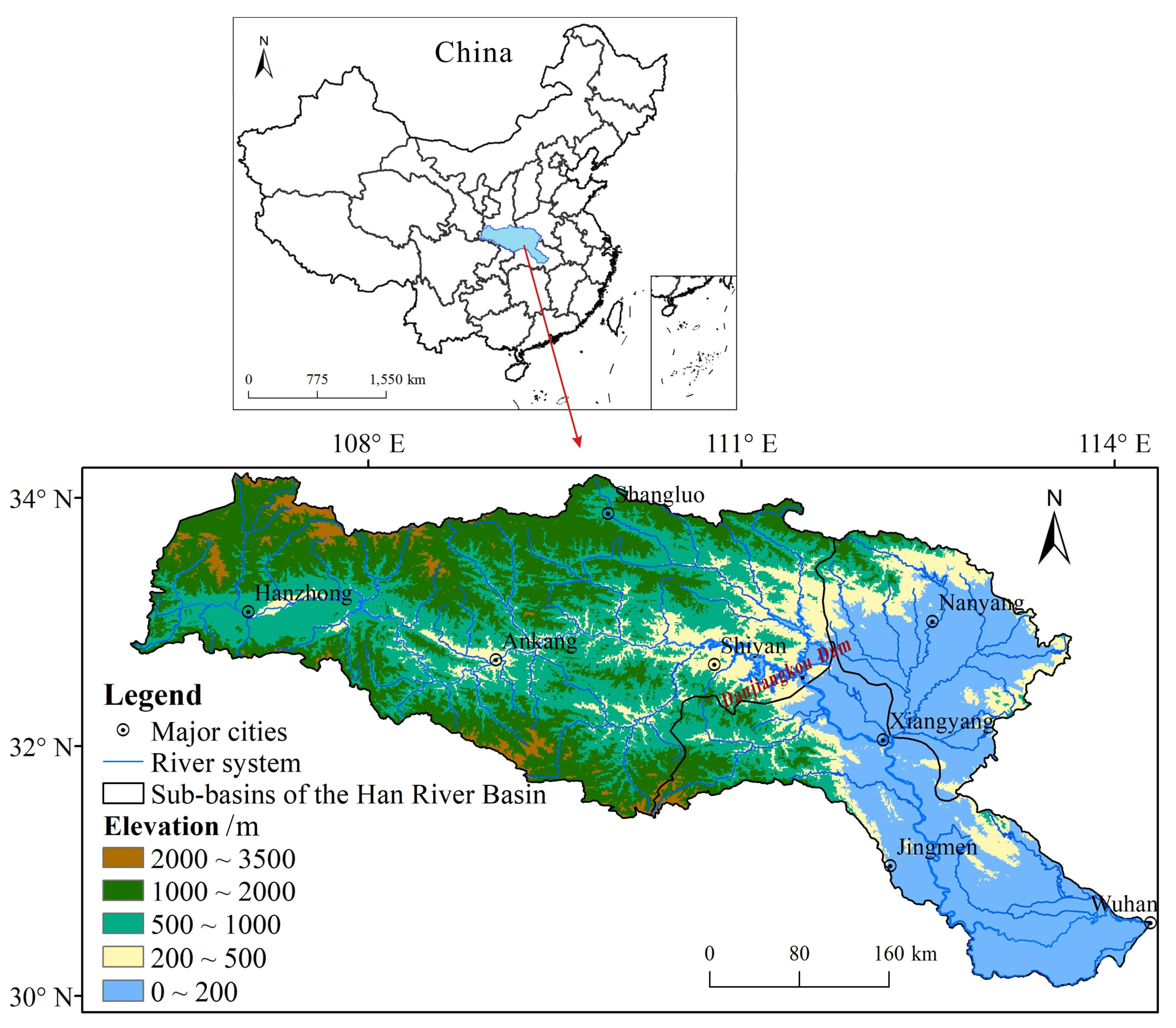
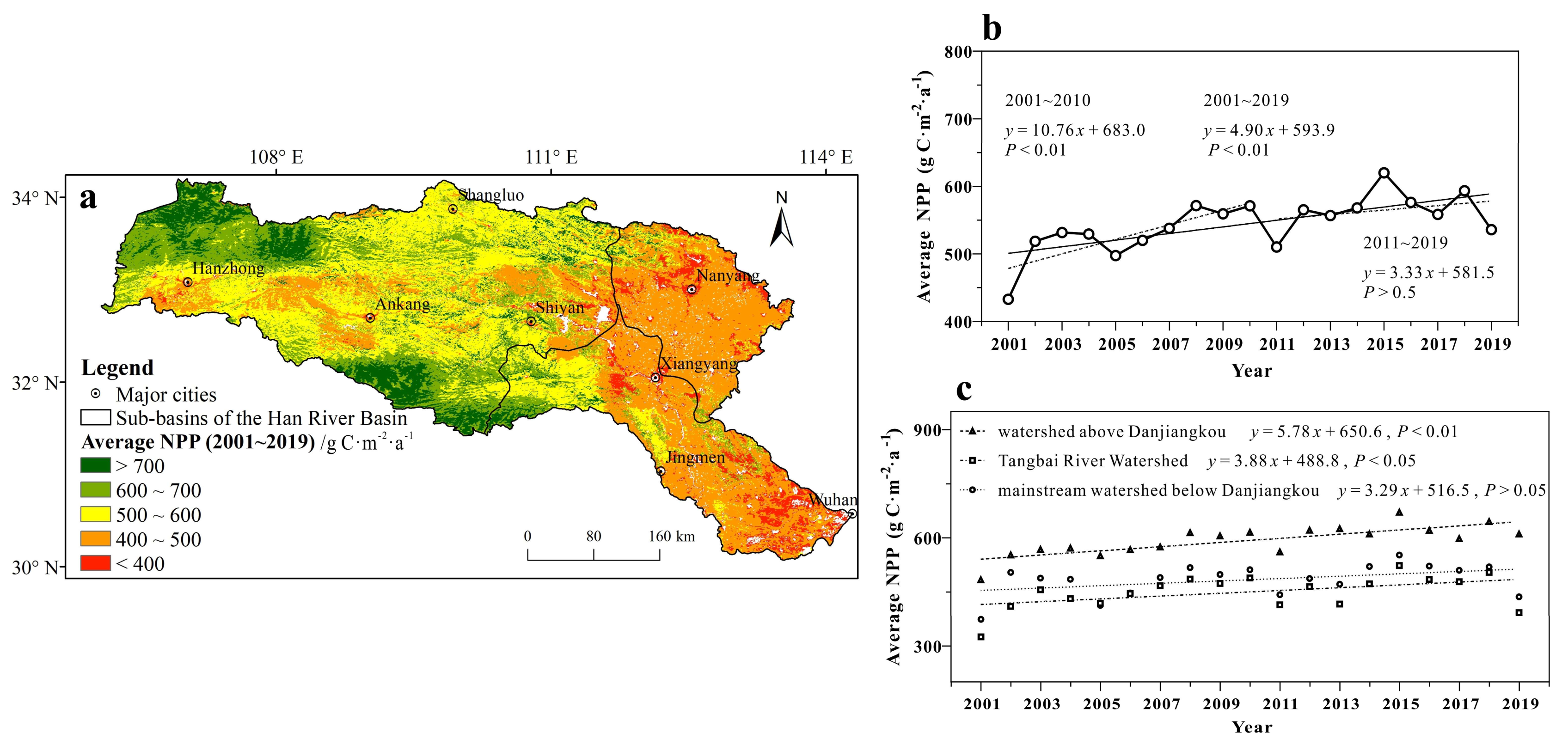

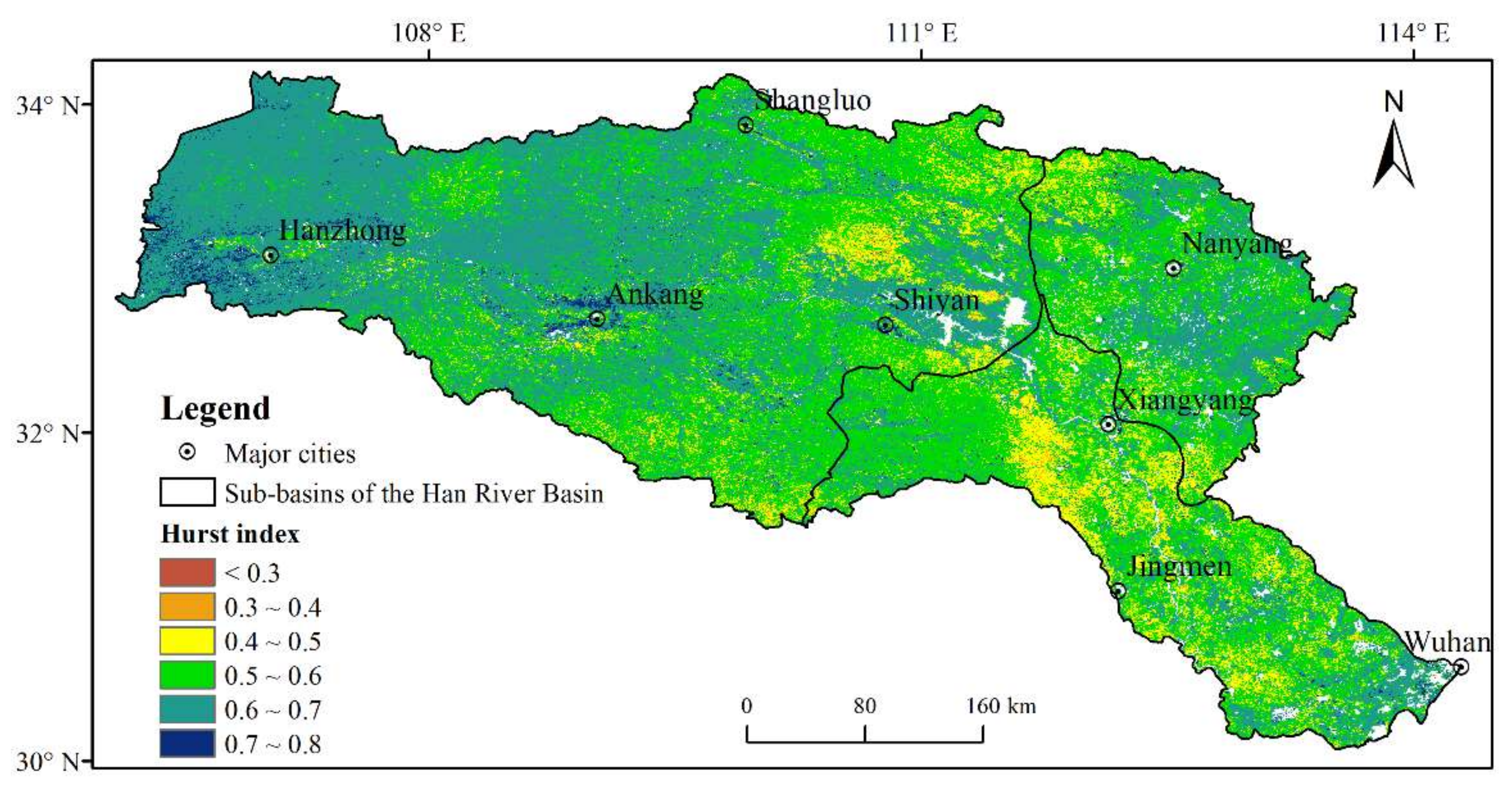
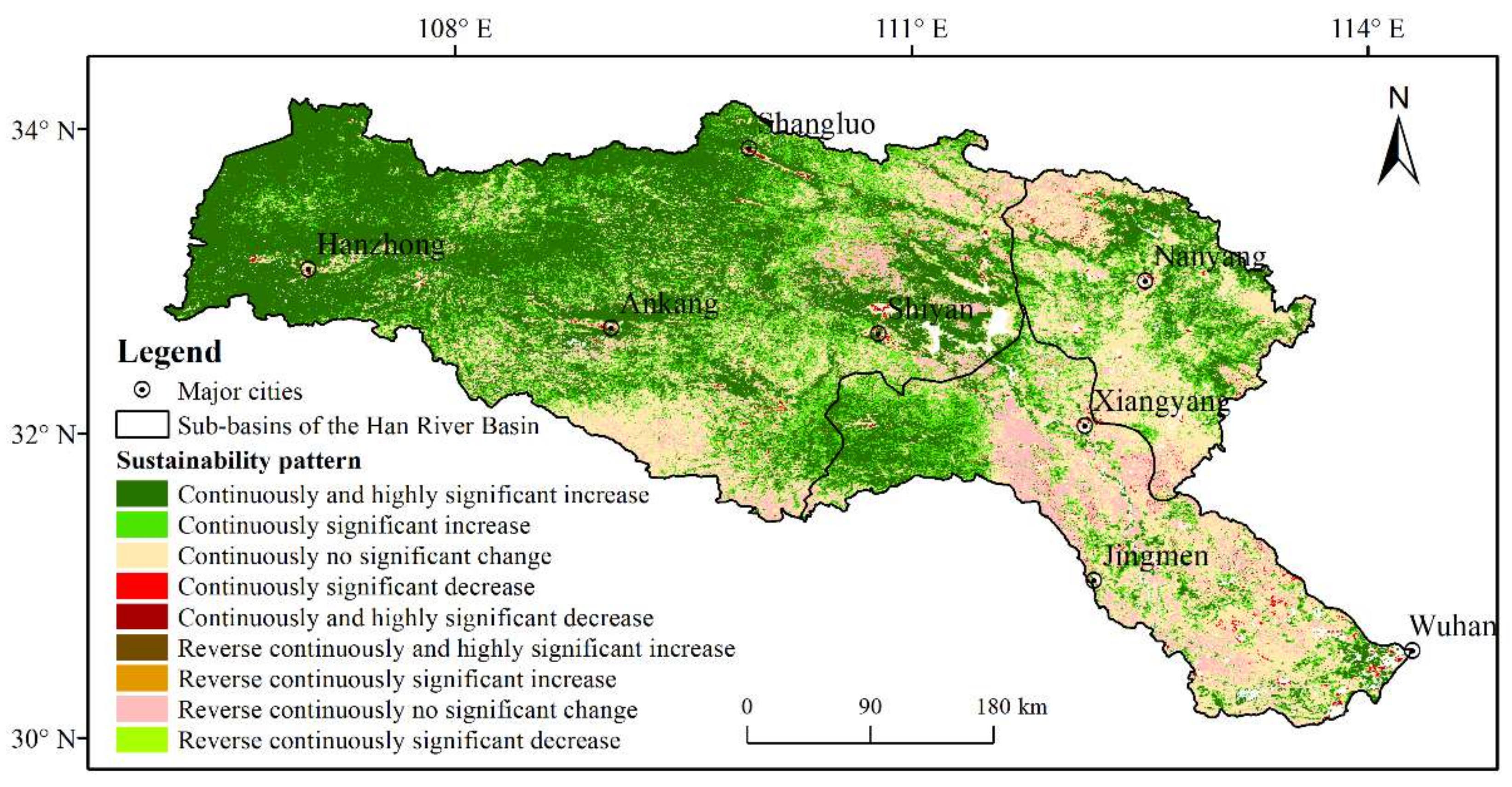
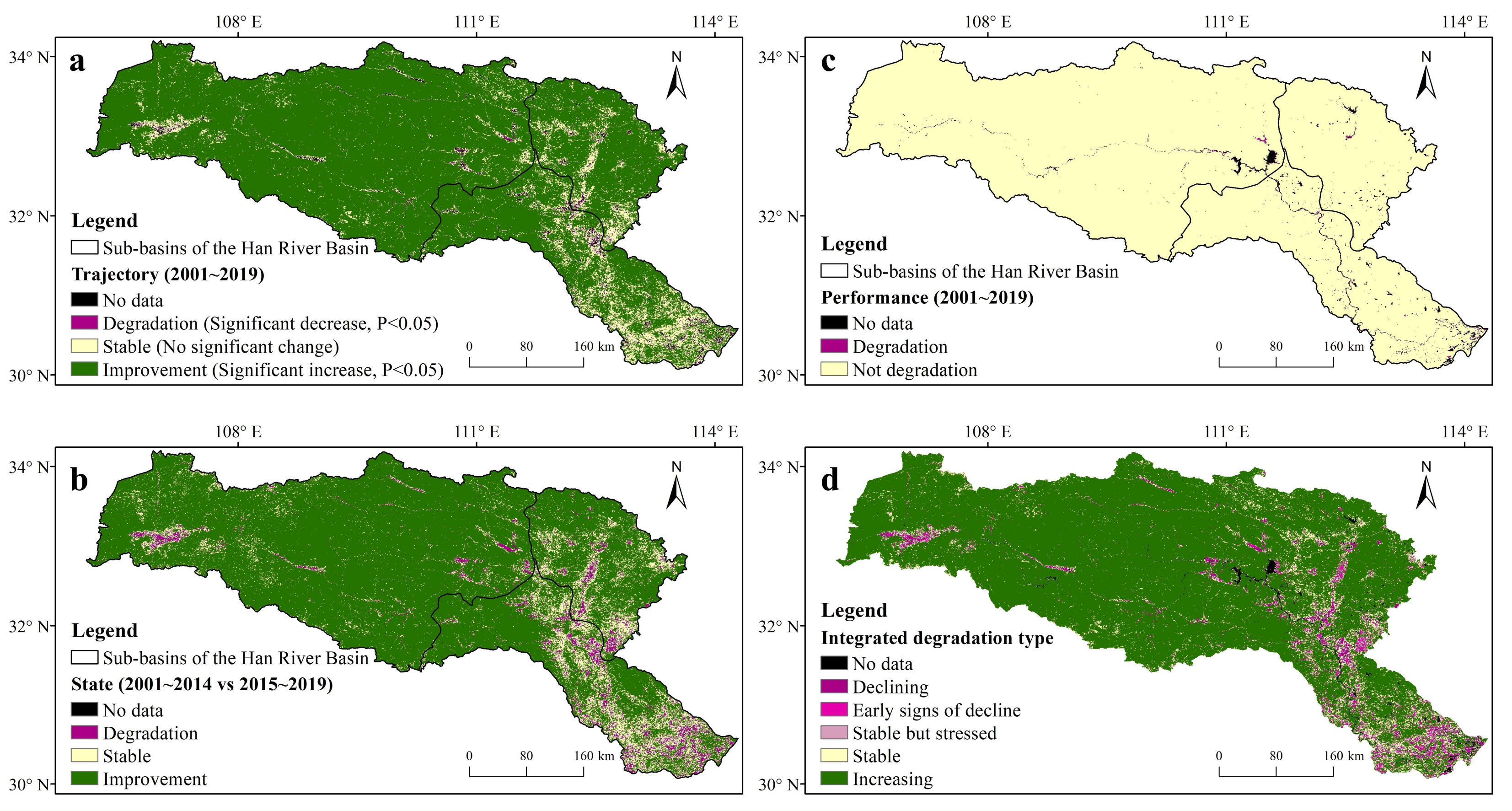


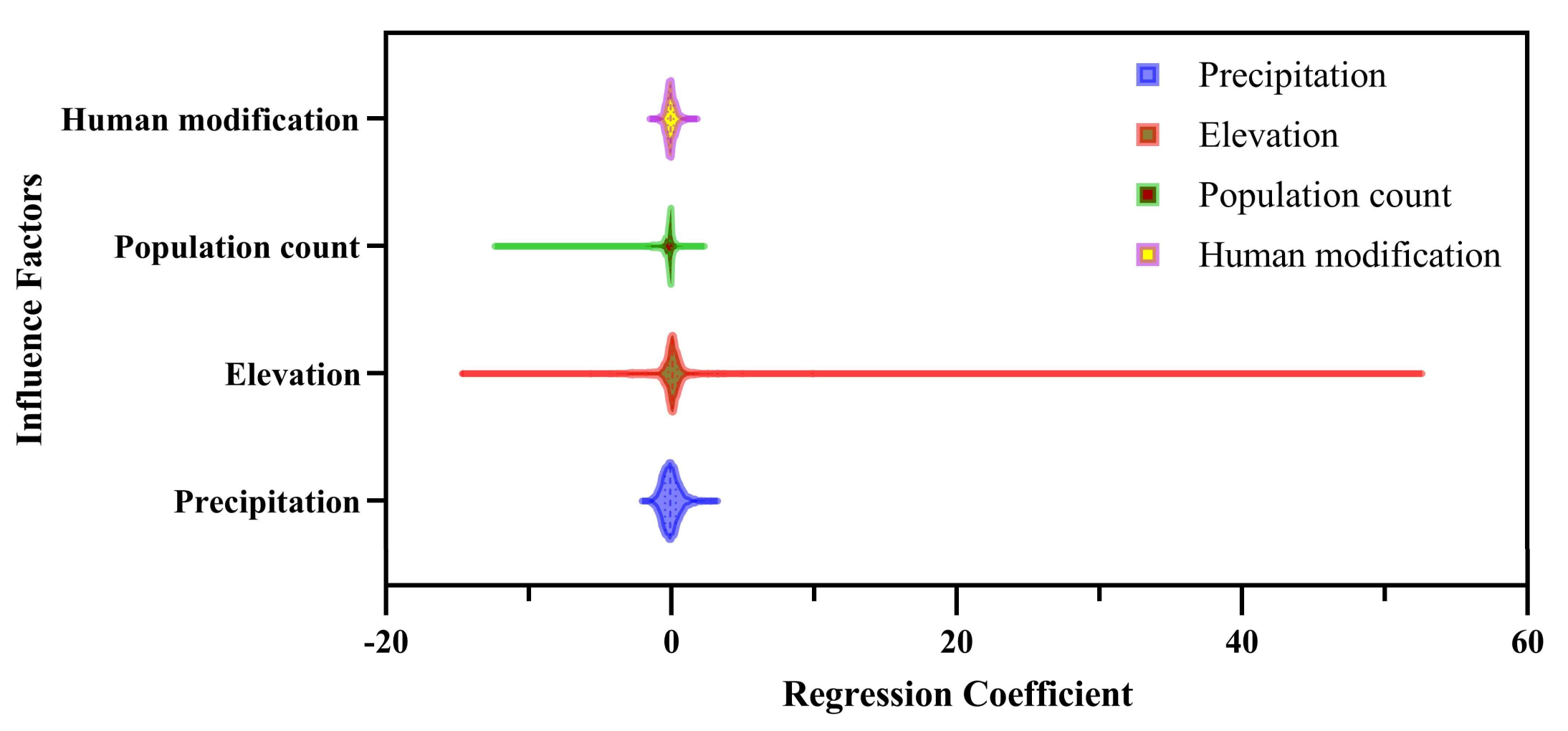
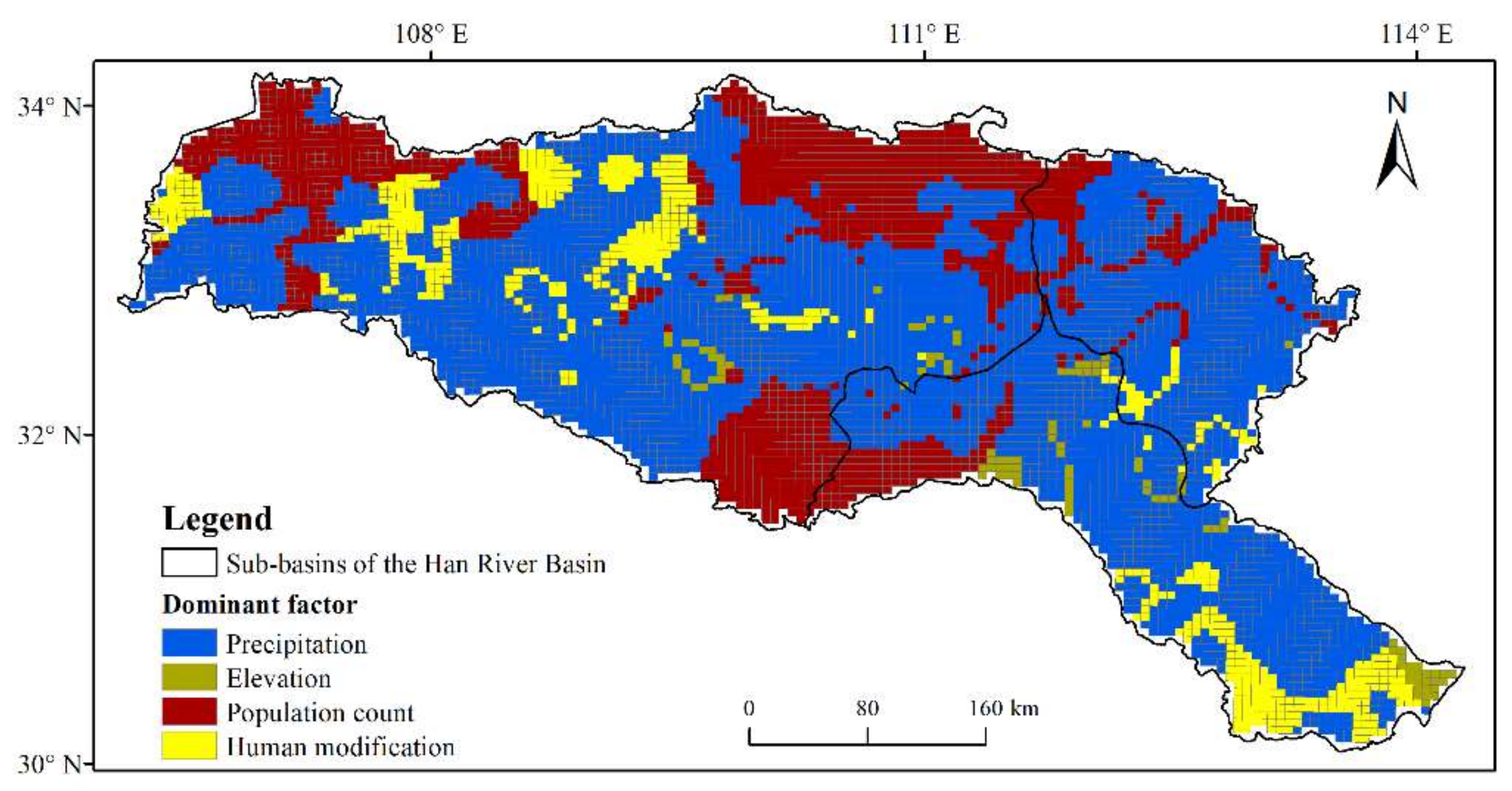
| Data | Source | Resolution |
|---|---|---|
| NPP | MOD17A3HGF, NASA | 500 m |
| Temperature | MOD11A1, NASA | 1000 m |
| Precipitation | CHIRPS | 0.05 arc degrees |
| Elevation/slope | NASADEM | 30 m |
| Forest cover | GFCC30TC, NASA | 30 m |
| Population count | SEDAC | 30 arc seconds |
| Human modification | SEDAC | 1000 m |
| Basin/watershed | China National Earth System Science Data Center | vector |
| Trajectory | State | Performance | Integrated Degradation Types |
|---|---|---|---|
| Improvement | Improvement | Stable | Improving |
| Improvement | Improvement | Degradation | Improving |
| Improvement | Stable | Stable | Improving |
| Improvement | Stable | Degradation | Improving |
| Improvement | Degradation | Stable | Improving |
| Improvement | Degradation | Degradation | Stable |
| Stable | Improvement | Stable | Stable |
| Stable | Improvement | Degradation | Stable |
| Stable | Stable | Stable | Stable |
| Stable | Stable | Degradation | Stable but stressed |
| Stable | Degradation | Stable | Early signs of decline |
| Stable | Degradation | Degradation | Declining |
| Degradation | Improvement | Stable | Declining |
| Degradation | Improvement | Degradation | Declining |
| Degradation | Stable | Stable | Declining |
| Degradation | Stable | Degradation | Declining |
| Degradation | Degradation | Stable | Declining |
| Degradation | Degradation | Degradation | Declining |
| Model Metrics | OLS | GWR | MGWR |
|---|---|---|---|
| AIC | 14,234 | 12,440 | 12,355 |
| Adjusted R2 | 0.318 | 0.562 | 0.565 |
| Bandwidth | 150 | 150 | Intercept (578), Precipitation (51), Elevation (5794), Population Count (485), Human Modification (645) |
Publisher’s Note: MDPI stays neutral with regard to jurisdictional claims in published maps and institutional affiliations. |
© 2021 by the authors. Licensee MDPI, Basel, Switzerland. This article is an open access article distributed under the terms and conditions of the Creative Commons Attribution (CC BY) license (https://creativecommons.org/licenses/by/4.0/).
Share and Cite
Hu, Y.; Wang, C.; Yu, X.; Yin, S. Evaluating Trends of Land Productivity Change and Their Causes in the Han River Basin, China: In Support of SDG Indicator 15.3.1. Sustainability 2021, 13, 13664. https://doi.org/10.3390/su132413664
Hu Y, Wang C, Yu X, Yin S. Evaluating Trends of Land Productivity Change and Their Causes in the Han River Basin, China: In Support of SDG Indicator 15.3.1. Sustainability. 2021; 13(24):13664. https://doi.org/10.3390/su132413664
Chicago/Turabian StyleHu, Yanxia, Changqing Wang, Xingxiu Yu, and Shengzhou Yin. 2021. "Evaluating Trends of Land Productivity Change and Their Causes in the Han River Basin, China: In Support of SDG Indicator 15.3.1" Sustainability 13, no. 24: 13664. https://doi.org/10.3390/su132413664
APA StyleHu, Y., Wang, C., Yu, X., & Yin, S. (2021). Evaluating Trends of Land Productivity Change and Their Causes in the Han River Basin, China: In Support of SDG Indicator 15.3.1. Sustainability, 13(24), 13664. https://doi.org/10.3390/su132413664





